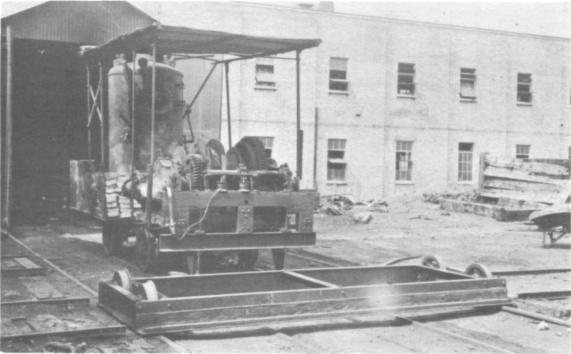
| THE INDUSTRIAL RAILWAY RECORD |
© MARCH 1967 |
AN UNUSUAL LOCOMOTIVE
SYDNEY A. LELEUX
W.H. Davis & Sons (Wagons) Limited had a very unusual locomotive at their Neasden works in North London. It was scrapped in mid−1959 and the remains were taken away by E. Hughes & Son of Brentford on 8th July 1959. According to the manager it had been built about 1900 and had come to Neasden from the Company’s works at Langwith Junction, Derbyshire, (where there had been a second similar locomotive) in the 1920-1930 period.
The works consisted of a long shed with several tracks along its length, approached by a siding from the Great Central Marylebone line. A traverser, running on sunken rails across the entrance to this shed, was hauled back and forth by the locomotive which was housed in a corrugated iron shed at one end of the sunken railway.
The locomotive comprised a platform carried on four double-flanged wheels. At one end was a vertical boiler (pressed at 100 lbs) which drove a two−cylinder marine-type winch mounted at the other end. A cog on the winch drove a shaft between the wheels by a heavy chain, and other chains transmitted the power from this shaft to the wheels. Beside the boiler was a low rectangular water tank. The boiler, chimney and safety valves protruded through the cab roof which was supported by a pillar in each corner, and the exhaust from the winch had a separate pipe up the back of the boiler. The traverser was coupled to the winch end of the locomotive.

The locomotive at Neasden in 1956. (F.Jones)
Wagons were moved on or off the traverser, and in the works, by a wire cable driven by the winch. If the wagon had to be moved away from the locomotive the cable was led round a pulley at the far end of the siding before being fastened to the wagon. It was to counteract the side thrust from the winch that the wheels were double-flanged.
(According to the Club’s records, there were two locomotives at the Langwith Junction works, and both are stated to have been built by A. Cudworth. One of these machines was transferred to Neasden and is the subject of the above article, whereas the other, of similar design but with coupled wheels, remained at Langwith Junction until it was broken up in the late 1950’s. Mr F. L. Pugh informs us that when he visited the Langwith Junction works in July 1955, the locomotive there carried a builders plate reading "Designed and Constructed by Arthur Cudworth, St. Marks Engineering Works, Wrexham". This firm later became the well known locomotive dealers Cudworth & Johnson Ltd. We would be grateful if any reader can confirm that the locomotive latterly at Neasden was, in fact, built by Arthur Cudworth. Unfortunately Messrs Cudworth & Johnson Ltd. have been unable to provide any information. - Hon. Eds.)